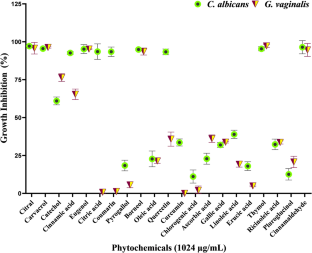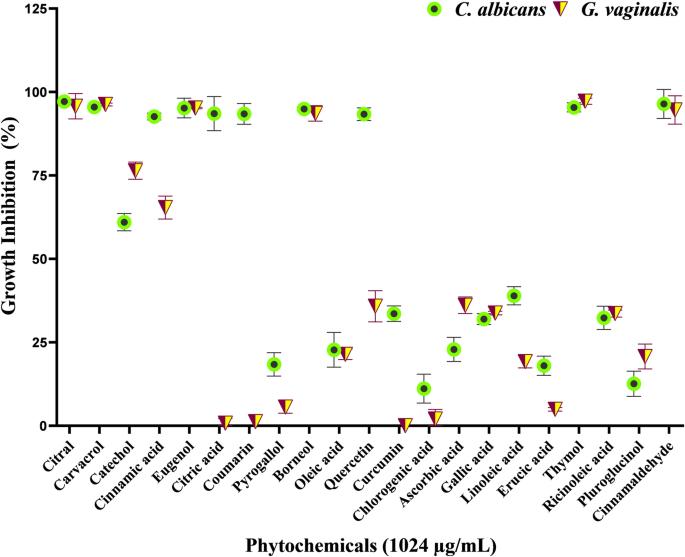Synergistic anti-virulence efficacy of citral and carvacrol against mixed vaginitis causing Candida albicans and Gardnerella vaginalis: An in vitro and in vivo study
IF 2.1
4区 医学
Q3 BIOTECHNOLOGY & APPLIED MICROBIOLOGY
引用次数: 0
Abstract
Mixed vaginitis due to bacterial vaginosis (BV) and vulvovaginal candidiasis (VVC) is the most prevalent form and presents a significant therapeutic challenge globally. Since, the administration of monotherapy leads to subsequent recurrent infections, synergistic therapy that completely eradicates both pathogens is of dire need to manage mixed vaginities scenario and to prevent its recurrence. The current investigation was focused on exploring the synergistic inhibitory efficacy of phytochemicals against the virulence traits of individual and mixed species of C. albicans and G. vaginalis in vitro and in vivo (Galleria mellonella). Out of five phytochemicals (carvacrol, thymol, cinnamaldehyde, eugenol, and borneol) screened for synergism with citral [(Ct) as the prime molecule owing to its myriad therapeutic potential], carvacrol (Ca) in combination with citral exhibited promising synergistic effect. Time-kill kinetics and one-minute contact-killing assays demonstrated the phenomenal microbicidal effect of Ct-Ca combination against both mono and dual-species within 30 min and one-minute time intervals, respectively. Furthermore, the sub-CMICs (synergistic combinatorial MIC) of Ct-Ca have significantly eradicated the mature biofilms and remarkably reduced the virulence attributes of both C. albicans and G. vaginalis (viz., yeast to hyphae transition, filamentation, protease production, and hydrophobicity index), in single and dual species states. The non-toxic nature of Ct-Ca combination was authenticated using in vitro (human erythrocyte cells) and in vivo (Galleria mellonella) models. In addition, the in vivo efficacy evaluation and subsequent histopathological investigation was done using the invertebrate model system G. mellonella, which further ascertained the effectiveness of Ct-Ca combination in fighting off the infection caused by individual and mixed species of C. albicans and G. vaginalis. Concomitantly, the current work is the first of its kind to delineate the in vitro interaction of C. albicans and G. vaginalis mixed species at their growth and biofilm states, together emphasizes the promising therapeutic potential of acclaimed phytochemicals as combinatorial synergistic therapy against mixed vaginitis


柠檬醛和香芹酚对白色念珠菌和阴道加德纳菌引起的混合性阴道炎的协同抗病毒功效:一项体外和体内研究。
由细菌性阴道病(BV)和外阴阴道念珠菌病(VVC)引起的混合性阴道炎是最常见的阴道炎形式,也是全球治疗上的一大挑战。由于单一疗法会导致随后的反复感染,因此迫切需要能彻底根除两种病原体的协同疗法来治疗混合性阴道炎并防止其复发。目前的研究重点是探索植物化学物质在体外和体内(Galleria mellonella)对白僵菌和阴道球菌单个和混合物种毒力特征的协同抑制功效。在筛选的五种植物化学物质(香芹酚、百里酚、肉桂醛、丁香酚和莰烯醇)中,香芹酚(Ca)与柠檬醛的协同作用很有希望。时间杀灭动力学和一分钟接触杀灭试验表明,Ct-Ca 组合分别在 30 分钟和一分钟的时间间隔内对单种和双种细菌产生了惊人的杀微生物效果。此外,Ct-Ca 的亚 CMICs(协同组合 MIC)能显著消灭成熟的生物膜,并显著降低白僵菌和阴道球菌在单种和双种状态下的毒力属性(即酵母到菌丝的转变、丝状化、蛋白酶的产生和疏水性指数)。Ct-Ca 组合的无毒性通过体外(人红血球细胞)和体内(灰孔雀)模型进行了验证。此外,还利用无脊椎动物模型系统 G. mellonella 进行了体内药效评估和随后的组织病理学调查,进一步确定了 Ct-Ca 组合在抗击白僵菌和阴道杆菌的单种和混种感染方面的有效性。同时,目前的研究工作也是首次描述白僵菌和阴道杆菌混合菌种在生长和生物膜状态下的体外相互作用,并强调了广受赞誉的植物化学物质作为混合阴道炎组合协同疗法的巨大治疗潜力。
本文章由计算机程序翻译,如有差异,请以英文原文为准。
求助全文
约1分钟内获得全文
求助全文
来源期刊

Journal of Antibiotics
医学-免疫学
CiteScore
6.60
自引率
3.00%
发文量
87
审稿时长
1 months
期刊介绍:
The Journal of Antibiotics seeks to promote research on antibiotics and related types of biologically active substances and publishes Articles, Review Articles, Brief Communication, Correspondence and other specially commissioned reports. The Journal of Antibiotics accepts papers on biochemical, chemical, microbiological and pharmacological studies. However, studies regarding human therapy do not fall under the journal’s scope. Contributions regarding recently discovered antibiotics and biologically active microbial products are particularly encouraged. Topics of particular interest within the journal''s scope include, but are not limited to, those listed below:
Discovery of new antibiotics and related types of biologically active substances
Production, isolation, characterization, structural elucidation, chemical synthesis and derivatization, biological activities, mechanisms of action, and structure-activity relationships of antibiotics and related types of biologically active substances
Biosynthesis, bioconversion, taxonomy and genetic studies on producing microorganisms, as well as improvement of production of antibiotics and related types of biologically active substances
Novel physical, chemical, biochemical, microbiological or pharmacological methods for detection, assay, determination, structural elucidation and evaluation of antibiotics and related types of biologically active substances
Newly found properties, mechanisms of action and resistance-development of antibiotics and related types of biologically active substances.
 求助内容:
求助内容: 应助结果提醒方式:
应助结果提醒方式:


